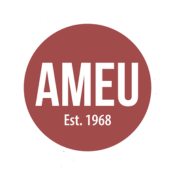By John F. Mahoney
According to documents in our files, the idea for AMEU came about in May 1967, the month before the Six Day War. The actual papers of incorporation , submitted to the state of New York in Nov. 1967, shows the names of three men and two women.
The first is Jack Sunderland, president of Aminoil, the Neutral Zone oil company between Kuwait and Saudi Arabia.
The next is John V. Chapple, the Mideast editor of the Encyclopedia Britannica, who spent most of his time in Greece where he owned a printing press in Athens.
The third is Edith E. Forbes, great granddaughter of Ralph Waldo Emerson.
The fourth is Dr. Helen Hilling, Professor of Public Administration at New York University, who had worked in several Palestinian refugee camps as a consultant on health care delivery services.
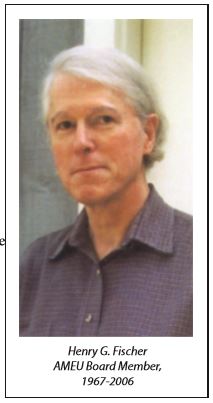
Lastly, there is Dr. Henry G. Fischer. Henry was assistant professor of Egyptology at Yale University and later head of the Department of Egyptology at the Metropolitan Museum of Art in New York City. Those who have visited the museum know that the focal point in the museum is the imposing Temple of Dendur. Henry was the major influence both in saving the Temple from being flooded by the Aswan High Dam, and in persuading President Johnson to relocate it inside the Metropolitan. In 1970, Lila Acheson Wallace, of Readers Digest fame, endowed a special chair for Henry as curator of Egyptology at the Metropolitan. And it was a one-time gift from Lila Wallace of $60,000, secured by Henry, that enabled AMEU to get on its financial legs. Henry was also a published poet and musician who remained on our board as AMEU’s vice president until his death in 2006.
The actual incorporation, however, turned out to be not so easy. At least one law firm refused to handle the application. Eventually a New York attorney was found and the papers were filed on Nov. 2, 1967.
On Nov. 22, 1967, the New York State Attorney General contacted our lawyer wanting to know “if the activities of the proposed corporation will be embarrassing to or in conflict with the United States Secretary of State, the United States Delegation to the United Nations, or to the Secretary General of the United Nations.” And he concluded: “Perhaps the U.S. Secretary of the State, the U.S. Delegation to the U.N. and U Thant should be consulted to see if our proposed corporation is acceptable to them.” The Attorney General told our lawyer he wanted to speak with “knowledgeable people” within the organization.
There is no record of such a meeting. AMEU was incorporated in January 1968, and received its tax exempt status in March 1969. A copy of its letterhead for March 17, 1969 now listed seven other board members in addition to the five signers of the papers of incorporation; they are:
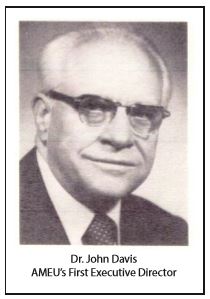
Dr. John H. Davis, a respected agronomist, former U.S. Assistant Secretary of Agriculture, and Harvard University professor who was tapped by President Eisenhower to become the first Commissioner General of UNRWA, the U.N. organization set up to help Palestinian refugees, a post he held from 1959 to 1964. When he returned to the States in ‘64, he made this observation: “To have lived in the area and with the Palestinians, one could not help but be affected by the suffering, and could not help feeling compelled to try to create the conditions for a just peace.” When John came home he did just that: he directed the N.Y. office of the American University of Beirut, he founded the U.S. office of the Musa Alami Foundation, a vocational school for West Bank orphans and, for a while in 1968, he served as AMEU’s first executive director. In that same year he moved to Washington to become the first president and board chairman of American Near East Refugee Aid (ANERA). Meanwhile he remained a member of AMEU’s board of directors until his death in 1988.
Other members of the original board of directors on that 1969 letterhead include:
Dr. Harry Dorman, Executive Director of the Middle East & Europe Department of the National Council of Churches in America.; Dr. I. Emmet Holt, board chairman of American Middle East Rehabilitation; Monsignor, later Bishop, John Nolan, president of the Pontifical Mission for Palestine and secretary of the Catholic Near East Welfare Association; Dr. Henry Van Dusen, president emeritus of Union Theological Seminary; Charles White, past financial executive of the Near East Foundation; and TheRev. Humphrey Walz, chairman of the Near East Sub-Committee of the Presbytery of New York City, and former associate executive of the Presbyterian Synod of the Northeast.
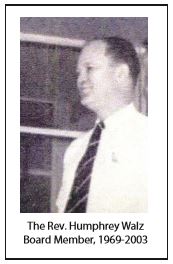
A word about Humphrey Walz. Following WWII, Humphrey worked in New York City, relocating Jewish refugees from the Third Reich; then, following the Middle East war of 1948-49, he worked with Palestinian refugees. He edited The Link for its first two years, and for several years he wrote a column on Religion and the Middle East for The Washington Report on Middle East Affairs. When he was dying and living in a home for the terminally ill, he formed a study group and had me send him copies of the latest Link for the group to discuss. Then one day I was notified by the home that he had slipped into a coma and that I should discontinue sending The Link. A month or so later I received a call from Humphrey himself. Seems the coma had been induced by a new medicine they had given him. When they decided to stop the medicine, he was back, his mind as sharp as ever, and he needed copies of the latest Link for his study group. He died soon after that — with his boots on.
Between that original board of directors and today’s we have had outstanding members. Space does not permit listing them all, but I would like to single out three.
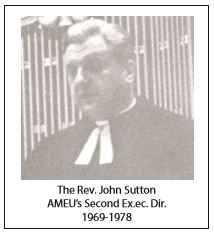
One is The Rev. John Sutton. John was a Methodist minister who pastored an American community in Athens Greece in the early 60s, during which time he came to know John Chapple , an AMEU board member also living in Athens. John Sutton returned from Greece in the mid-60s to lead a Methodist church in Weston, MA, where, as fate would have it, I was teaching at a Catholic seminary. We became close friends.
When John Davis stepped down as director in 1968, my guess is that John Chapple recommended John Sutton for the job. And for 9 years, until I succeeded him in 1978, John did an extraordinary job. He had assembled a mailing list of over 40,000 names. More, he had put together a highly professional staff. And, as an enduring legacy, just before I came on board, he invited me to go with him to a seminar in fundraising at the University of Illinois, where I learned that a self-addressed return envelope for fundraising should be a hot color, preferably pink. And as readers to The Link know only too well, that is a tenant of fundraising I’ve observed scrupulously. John and I remained close friends until his death in 1990.

Another board member I’d mention is Grace Halsell, who once served as a staff writer for President Johnson. I’ve been thinking of Grace these days with all the talk about the racial divide in America. She used to tell of the time LBJ asked his cook, Zephry White, to transport two dogs overnight in her car. “You have no idea, Ms White told Johnson, “what it is like for a Negro to try and get a decent hotel room – and you are asking me to take two dogs?”
The question haunted Grace. She left the White House and consulted with dermatologists at Yale and Harvard. They told her about a medication which, when taken in conjunction with exposure of the body to intense tropical sun, would darken one’s skin. Grace took the medication and headed for a Caribbean island. “One day,” she would later write, “I looked in a mirror and saw a black woman looking back at me.” For the next year Grace learned what it was like being an African-American woman. Her book “Soul Sister” sold over a million copies.
In the later 1970’s Grace decided to go to Jerusalem to live with a Jewish, a Christian, and a Muslim family. The publishers at Macmillan gave her an advance. Her book, “Journey to Jerusalem” came out in 1981. It did not sell a million copies. Macmillan did little to promote the book, and Grace’s lecture agent, reacting to strong pressure, dropped her. That’s when she came knocking on the doors of any organization that might help her. I remember when she came to our office and left a copy of her book. I took it with me to read on the train commute home, and nearly missed getting off at my station stop. It wasn’t that what she had written was news to me — it was the unprecedented fact that it was being said by a respected journalist in a mainstream publication. AMEU bought the rights from Macmillan to do a second run and in all we have distributed over 24,000 copies of “Journey to Jerusalem.” In 1982, the directors invited Grace to join the board. She did, and for 18 years until her death she remained one of our most active members. Her feature articles for The Link are available on our website: www.ameu.org.
The third board member I’d like to mention is John Goelet, who joined our board in 1998. John and his wife Henrietta have accomplished extraordinary work on behalf of the Palestinians. It is Henrietta who is responsible for the publication “Remember These Children…” a periodically updated listing of Israeli and Palestinian children killed in the violence. Presently, the Goelets are engaged in helping AMEU transition from a print medium to various digital platforms.
AMEU’s Presidents
In its 50-year history, AMEU has had only three presidents.
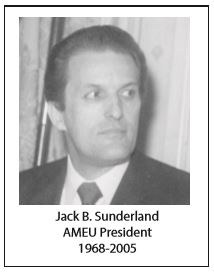
Jack B. Sunderland
I had the honor of speaking at Jack’s memorial service in July 2005. I noted that Jack was associated with the Near East Foundation and the American Near East Refugee Aid, both humanitarian organizations that help hundreds of thousands of individuals.
In contrast, AMEU is an educational organization. Our goal is to explain to Americans that what happened in 1948 was not a war of independence but ethnic cleansing, that what happened in 1967 was more ethnic cleansing, and that what is happening today with each housing unit that is built in the West Bank is yet more ethnic cleansing — and that it’s all being done with our money and our moral authority.
To say that, even to hint at it, can get you into trouble. Jack discovered this early on when, in an interview he gave in Europe, he suggested that peace would come to the Middle East only when Israel stopped building settlements on occupied Palestinian land.
The next thing he knew someone was knocking on his neighbors’ doors in Scarsdale N.Y., inquiring about his children and the times they went to school. Jack hired a detective and the detective, working with the FBI, discovered that the person making the inquiries — who had also gained computer access to his finances and credit record -– was employed by a major pro-Israel organization. The full story is reported by former U.S. Rep. Paul Findley in his book “They Dare to Speak Out: People and Institutions Confront Israel’s Lobby.”
It still impresses me that a man who was financially well off would subject himself and his family to such harassment. My explanation, based on 27 years of knowing him, is that Jack sincerely felt that our foreign policy in the Middle East, if not changed, would lead to catastrophic consequences for the Palestinians, and disastrous consequences both for us and for the Israelis. For 37 years, as president of AMEU, Jack tried to change our lopsided support of Israeli suppression of Palestinian rights. I think of former U.S. Attorney General Ramsey Clark who once said that the truest test of a person’s support for human rights is their support of Palestinian rights. Jack passed that test.
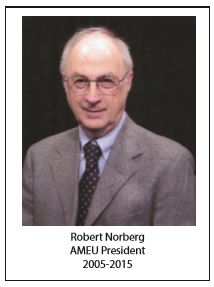
Robert L. Norberg
Bob Norberg joined AMEU’s board of directors in 1995, soon after retiring as director of the Washington office of the Arabian American Oil Company. By profession, Bob is a journalism graduate of the University of Minnesota, and his first job was managing and editing twin newspapers in Iowa for five years.
These skills soon became visible in every phase of our Link publication, from the selection of the topic and author to the final layout. Bob, we discovered with great relief, could also navigate the arcane world of computer wizardry. He created and managed AMEU’s website, and he arranged, with a grant from Grace Halsell’s estate, to have all our Link issues going back to 1968 digitized. These are issues that have long been buried inside a three ring binder, issues that now have a new life in cyberspace. The last time I saw Jack Sunderland before he died in 2005, I was able to tell him that Bob had agreed to become AMEU’s second president. Jack was very pleased.
In 2015, Bob stepped down as president — only to become AMEU’s first president-emeritus. The plaque the board presented him, read, in part,: “We the Directors and Staff of AMEU, thank you, Bob, for your steadfast leadership, your high standard of journalism, and your exemplary fulfillment of AMEU’s stated mission to focus on the ‘moral dimension of Middle East issues that are of critical importance to the American discourse, particularly the Israeli-Palestinian dilemma.’”
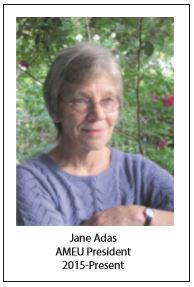
Jane Adas
Back in 1991, I received one of those penny postcards with the one sentence: “If you can use volunteer help, I’d be happy to come in a day each week.”
The first day Jane came to the office, I asked if she’d mind sending out the overseas mailing of the latest Link. No, she wouldn’t mind. In short time, I came to realize that Jane, who actually was Dr. Jane Adas of Rutgers University, knew a thing or two or three about the Middle East.
Today, 25 years later, Jane still does the overseas mailing in addition to keeping track of all contributions, maintaining our mailing list, overseeing our book and video catalog, and proofing the Link manuscripts when they come in. She has been a columnist for The Washington Report on Middle East Affairs and, in 2009, authored an article for The Link on the devastation wrought by Israel’s “Operation Cast Lead” assault on Gaza. And six times now, she has put her body where her words are by spending six weeks at a stretch in Hebron with the Christian Peacemaker Teams, where she stood between the Palestinians who live there and the Jewish settlers who threaten to take ever more of their land.
In 1998, Jane was appointed to our board of directors. In 2004, she was appointed vice-president. In 2015, by unanimous vote, she became AMEU’s third president.
Never did a penny postcard pay such dividends.
AMEU’s Staff
Shibabaw
AMEU is located next to Columbia University, Barnard College, and Union Theological Seminary, and for years, we had a ready supply of school interns whom we used for special projects.
But, in 1986, I received a letter from a professor in Ohio, a Link subscriber. He said that one of his students, a Shibabaw Wubetu, had just graduated with a degree in accounting and was coming to New York City to look for a job. He said he told Shibabaw to drop by AMEU in case we had an opening.
Shibabaw did drop by, and we did have an opening. And for 29 years, he served as our accountant and office manager. He is also the one we instinctively turned to whenever our computer told us that our data had gone down some black cosmic hole.
During these years we celebrated Shibabaw’s wedding and the birth of his son. Shibabaw retired in December 2015, and we miss him.
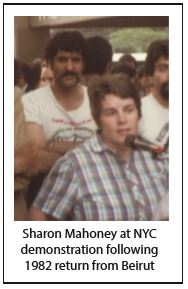
Sharon
My wife Sharon is as much a part of AMEU as I am. Often she is the one who answers the office phone; she is there at the conferences we attend, selling books and videos and, if you bought a bottle of the Jerusalem olive oil that we are now offering, it was Sharon who packaged it.
Her commitment is that of the eyewitness. In 1982, she joined a medical team to assess the possibility of volunteer doctors and nurses setting up clinics in Palestinian refugee camps in Lebanon. The delegation arrived on the very day in June 1982 when the first Israeli bombs fell on Beirut. One of the early casualties came from an implosion bomb that hit a yellow school bus on an open highway. When they brought the students into the makeshift emergency room where Sharon, a registered nurse, was working, the bodies were so inflated and purple she could not tell if they were boys or girls.
When she returned to the States she told what she had seen to Jane Pauley on the Today show and to David Brinkley on his Sunday program, as well as to numerous talk radio shows, and to anyone who would listen to her on Capitol Hill. A few weeks later, when she went to get her nursing job back, she was turned down because of her support for Palestinians. We ‘lawyered’ up and she got her job back.
AMEU Projects
Books and Videos
I would estimate that, over the past 50 years, AMEU has sold over $1 million worth of books and videos. Much of this is from the “pre-Amazon” years, when it was difficult to find good books on the Palestinian situation printed in the United States and we had to import them, often from England. We even printed our own seasonal catalog, which offered “hard to find books at highly discounted prices.” We still offer around 100 books and videos on our website, many of them classic books that are now out of print — and now costing hundreds of dollars on Amazon!
Special Affairs Series
Again, in the pre-computer age, we reprinted and distributed articles and speeches that we thought deserved wider availability. Several of these are now on our website. Two, in particular, I would single out:
“Zionism: A Form of Racial Discrimination.” This is the brief presented by Dr. Fayez Sayegh, in the Fall of 1975, at the 30th session of the United Nations General Assembly. The General Assembly adopted the resolution that Zionism is “A Form of Racism and Racial Discrimination.” Dr. Sayegh’s brief is a meticulously documented presentation based largely on the official records of Zionist organizations and Jewish newspapers. In 1991, the U.N., under intense U.S. pressure, rescinded its 1975 resolution. AMEU’s Public Affairs Pamphlet #30, also on our website, makes the case that the U.N. got it right the first time.
“Lest We Forget: The U.S.-Israel Relationship: The Illusion of an Imaginary Common Interest.” This is a chronology of the times Israel has blatantly pursued its self-interest counter to U.S. interests, especially our demands that it cease all illegal settlements on Palestinian lands It is now in its fifth edition.
Holy Land Tours

Most organized tours to the Holy Land take tourists to see the holy places: Bethlehem, Nazareth, Jerusalem. Few take them to meet the people who live in these places. In the 1980s and 90s, AMEU sponsored trips to the Holy Land where we met with Palestinian guides, religious leaders, and human rights organizations. Several of our tours were led by Fr. Ed Dillon, a Catholic biblical scholar now on our board of directors. For those going on a non-AMEU trip or on their own, we prepared a catalog of recommended guides, hotels, and organizations.
The Link
When I came to AMEU some 39 years ago, one question that kept popping up in my mind was why “The Link”? Couldn’t they have come up with a better title, say, The New York Report on Middle East Affairs?
The answer is that, prior to the 1967 war and shortly thereafter, there were small groups cropping up, especially in New York, in support of the Palestinians, and The Link was intended, in part, as a newsletter to promote the activities of these groups.
Today, The Link is a bimonthly magazine, with each issue devoted to a single critical topic, one not usually covered in depth, if at all, in the mainstream press. In addition to our general readership, The Link goes out to over 1,400 public and school libraries, including major colleges and universities. It is read by diplomats, journalists and activists. Space does not allow me to mention all our outstanding issues over the years, but let me note a few.
The Link has introduced several new authors who are now well known. They include:
Ali Abunimah, whose 1998 Link “Dear NPR News…” highlighted his one-person campaign to correct errors in the media’s coverage of the Palestinian issue. He later would co-found The Electronic Intifada, arguably the number one online publication for information on the question of Palestine.
James Wall, whose Sept.-Oct. 2000 Link “On the Jericho Road” told of his eye-opening experience during an American Jewish Committee-sponsored trip to Israel. Jim, the former editor of the influential Christian Century magazine, now writes a highly praised blog Wallwritings, and has single-handedly helped reshape the discourse about Palestine in key Christian circles. His blog is available on our website: www.ameu.org. Jim has been an AMEU board member since 2000.
David Wildman, whose Aug.-Sept. 2006 Link “Why Divestment? And Why Now?” explained why the boycott, divestment, and sanctions strategy (BDS) will work for the Palestinians. Wildman, who had been a prominent church activist in the South African anti-apartheid movement, is today a leading church proponent of the Palestinian BDS movement.
While our work has helped support and advance activism, we have also published original information about the Nakba and other little-known aspects of Palestinian history. This includes first-hand accounts never before published, such as:
“The Lydda Death March” (July-Aug. 2000) by Audeh Rantisi and Charles Amash, two Palestinians who give independent personal accounts of the infamous 1948 Zionist expulsion of Palestinians from Lydda.
“The Jews of Iraq” (April-May 1998) by Naeim Giladi, an Iraqi Jew who offers personal details on how Zionist Jews killed Iraqi Jews in order to force other Iraqi Jews to leave for Israel. This has been our most downloaded issue, perhaps because it sheds light on an important but little known aspect of the Jewish exodus from Arab lands.
“Epiphany at Beit Jala” (Dec. 1995) by Donald Neff, Time Magazine’s Jerusalem Bureau Chief. Neff went to Jerusalem, firmly accepting the Zionist narrative until, one day, he had to go to Beit Jala and, as he tells in this copyrighted article, what he saw there changed him for the rest of his life. It also got him into trouble with Henry Kissinger and eventually led to his dismissal as Time’s Jerusalem bureau chief.
Some of the original articles published by The Link have led to highly acclaimed books. These include:
“The Arab Stereotype on Television” (Apr.-May 1980) by Jack Shaheen. This was the basis for Jack’s bestselling book “The TV Arab,” which helped make him today’s preeminent Arab American media critic.
“Save the Musht — and the Land of Palestine” (Oct.-Nov. 1993) by Rosina Hassoun. This issue by a young doctoral candidate in Biological Anthropology contrasts the Zionist and Palestinian paradigms of land, and led to her article in the 1997 book “Water, Culture and Power.”
“What if the ruins of King Solomon’s Temple are NOT under the Dome of the Rock?” (July-Aug. 2014) by Dr. George Buchanan. Buchanan’s research, accepted now by some Israeli and non-Israeli archaeologists, led to his 2015 book “The “Strange Little City of Ancient Zion.” This is the only Link issue that has been translated into Arabic.
Other original research we have published include:
“The Window Dressers: The Signatories of Israel’s Proclamation of Independence” (Jan.-March 2015) by Ilan Pappe, the noted Israeli historian, who examines the backgrounds of the signers of Israel’s Proclamation of Independence.
“Israel’s Bedouin: The End of Poetry” (Sept.-Oct. 1998) by Ron Kelley, a professional photographer, who secretly documented Israel’s confiscation of Bedouin lands and its systematic destruction of their culture. Kelley presents his evidence exclusively in this Link article, which has become a standard reference work on the subject.
“U.S. Aid to Israel: The Subject No One Mentions” (Sept.-Oct. 1997) by Richard Curtiss. In addition to the billions of dollars in economic and military aid the U.S. gives Israel annually, Curtiss reveals the numerous, little known, funding arrangements that add billions more each year.
We continue to provide in-depth coverage of Israel’s war crimes, including:
“When War Criminals Walk Free” (Dec. 2012) by the Norwegian doctor Mads Gilbert, a first-hand witness to Israel’s Cast Lead incursion into Gaza.
“Can Palestine Bring Israeli Officials Before the International Criminal Court?” (Sept.-Oct. 2014) by John Quigley, Prof. of International Law at Ohio State University, who spells out the legal grounds on which Palestine can act.
“Confronting the Bible’s Ethnic Cleansing in Palestine” (Dec. 2000) by Michael Prior, a Catholic biblical scholar who addresses the question: Did God instruct the Israelites to rid the “Promised Land” of its indigenous people?
“Agro-Resistance” (Sept.-Oct. 2016) by British journalist Jonathan Cook, highlights one of the most promising enterprises happening today in the Palestinian economy. Whole Foods is selling the product…and so is AMEU.
What lies ahead
This issue of The Link has focused on the past 50 years. But we should go back another 30 years, to 1937, to comprehend what exactly we are focusing on.
In 1937, His Majesty King George VI promulgated the Palestine Defense Order in Council. It authorized the British High Commissioner in Palestine to enact such regulations “as appear to him in his unfettered discretion to be necessary or expedient for securing public safety, the defense of Palestine, the maintenance of public order and the suppression of mutiny, rebellion, and riot and for maintaining supplies and services essential to the life of the community.” Included in the regulations:
*The billeting, at the expense of the local population, of additional police in areas where the inhabitants had failed to render all the assistance in their power to the police or other authority for suppressing disturbances.
*The requirement that all persons in Palestine obtain a police license in order to hold a meeting or procession.
*The setting up of Military Courts to deal with offences against public order. Persons convicted of carrying firearms, ammunition, or bombs would face the death penalty.
The Palestine Defense Order concluded by noting that supernumerary police were enrolled and trained “to safeguard essential communication, to implement other police dispositions and to ensure adequate protection for Jewish settlements.”
This was nothing new for the preeminent colonial power. To keep rebellious subjects under its control the British Raj in India passed the 1915 Defense of India Regulations Act, and again, in 1919, the Rowlatt Act. This latter allowed for arrests without warrant of any suspected terrorist, indefinite detention without trial, and private trials without a jury for proscribed political acts in which the accused knew neither their accusers nor the evidence against them. Mohandas Gandhi called it the “Black Act,” and it sparked his campaign of nonviolent resistance.
Following the war, in 1923, Great Britain, as expected, was given the League of Nations Mandate for Palestine, with administrative rule over the southern part of the Ottoman Empire. Written into the Mandate was Lord Balfour’s 1917 Declaration.
The main obstacle, of course, with establishing a national home for the Jewish people in Palestine was the small number of Jews then living in Palestine. In 1919, President Wilson’s King-Crane Commission reported that 90% of Palestine’s inhabitants were “non-Jewish,” — read Palestinian Muslims and Christians — and that these “non-Jews” were “emphatically against the entire Zionist program.”
So the first order of business for the Zionists was to colonize Palestine. Indeed, one organization created in 1924 for that purpose called itself the Palestine Jewish Colonization Association. At a time when Great Britain was struggling to hold on to its empire, the last European colonizing enterprise of the 20th century was well underway. In just the year 1933, the number of Jews immigrating to Palestine was over 30,000; in 1935, that figure exceeded 40,000; and in 1935 it surpassed 60,000.
In 1936, the Palestinians revolted. At first it took the form of strikes and public protest. Then, in late 1937, it turned violent. In the eyes of the colonial power these were rebellious subjects, guilty of “lawlessness” and “banditry,” who had to be taught a lesson. That lesson would come in the legal guise of the draconian regulations set forth in the Palestine Defense Order in Council.
Two years later, in 1939, when the riots ended, over 10 percent of the adult male Palestinian Arab population between ages 20 and 60 was killed, wounded, imprisoned or exiled.
The crackdown allowed the Zionists to continue apace with its colonization of Palestine: Between 1900 and 1939, Zionist colonies had grown from 22 to 200. From 1922 to 1939, Jewish landholdings in Palestine went from 148,000 acres to 383,350 acres. And from 1918 to 1939, the Jewish population in Palestine had increased from 60,000 to 429,605. Jews now constituted 28% of Palestine’s population.
Then came WWII, and suddenly Great Britain had new priorities; now it needed Arab support. So, in 1939, His Majesty’s Government issued a White Paper saying it had fulfilled its pledge to establish a “Jewish national home” in Palestine, and that indefinite Jewish immigration and transfer of Arab land to Jews was contrary to the Covenant of the League of Nations and to British promises to the Arabs.
Enraged, the Zionists launched a campaign of terror that included blowing up a bus, a train, a ship, a café, a hotel, assassinating a diplomat and a peace negotiator, killing hostages, sending letter bombs, and massacring defenseless villagers. Menachem Begin, leader of the Irgun, the gang that carried out many of these acts — and a future prime minister of Israel — would boast that he was “Terrorist Number One.” (Bleier; The Link, July-August 2003, p1-4).
The British responded with their Emergency Defense Regulations 1945. These included the 1937 regulations, plus many more. When printed in the Palestine Gazette, they took up 41 pages.
The Zionists went ballistic:
David Ben-Gurion, the future first prime minister of Israel, called them “Nazi laws.” (Lazar, “Out of Palestine”, p.109)
Dr. Dov Yosef of the Jewish Agency and a future Israeli minister of justice asked: “Are we all to become victims of officially licensed terrorism or will the freedom of the individual prevail?…As it is, there is no guarantee to prevent a citizen from being imprisoned for life without trial…There is no appeal against the decision of the military commander…while the administration has unrestricted freedom to banish any citizen at an moment. What is more, a man does not actually have to commit an offence; it is enough for a decision to be made in some office for his fate to be sealed. All of the 600,000 [Jewish] settlers could be hanged for a crime committed by one person in this country.” (Jiryis , “The Arabs in Israel,” pp. 11-12)
When the war ended in 1945, the Zionist leadership drew up plans to put an end to Britain’s Mandate in Palestine, along with its intolerable defense regulations. And, as noted, the Zionists launched their campaign of terror. On October 31 of that year, for example, the elite Jewish commando group the Palmach, together with the Irgun and Stern Gang, blew up train tracks throughout Palestine as well as the Haifa oil refinery. (Taylor, “Prelude to Israel,” pp. 97-98)
It worked. On April 2, 1947, Britain decided it wasn’t worth the effort to quell the revolt and asked the United Nations to place the question of Palestine on its agenda. In November, the U. N. General Assembly recommended “provisionally” to partition Palestine into an Arab state and a Jewish state; the Jews, now one-third of the population and owning 7% of the land, were allocated 54-55% of the land, with Jerusalem as a corpus separatum.
But the Zionists wanted more. In April 1948, Irgun terrorists massacred 254 Palestinians in the village of Deir Yassin, launching the first of hundreds of land-clearing operations that resulted in over 750,000 Palestinian refugees, leaving the Zionists in control of 78% of the land.
On May 14, 1948, 37 Zionist leaders signed Israel’s Declaration of Independence, thereby proclaiming the existence of the State of Israel.
Israel now became the new colonial power and, five days following its founding, the first legislative act of its Provisional State Council was to incorporate the Defense Emergency Regulations into Israeli domestic law. For the next 69 years, and counting, Palestinians would be ground down by those very regulations that Jews had so vehemently decried as “Nazi laws.”
The question is why? Why did Jews so readily adopt these Emergency Regulation, the same ones some 400 Jewish lawyers had condemned at a conference of the Lawyers Association held on Feb. 7, 1946 in Tel Aviv, when it resolved: “The powers given to the ruling authority in the Emergency Regulations deny the inhabitants of Palestine their basic human rights. These regulations undermine the foundation of law and justice, they constitute a serious danger to individual freedom, and they institute a regime of arbitrariness without any judicial supervision.” (Sabri Jiryis, “The Arabs in Israel,” pp. 9-14, for this and following quotes.)
Speaking at that same conference, Dr. Moshe Dunkelblum, a future Supreme Court judge in the new Israeli state, said: “It is true that these laws threaten every Jewish settler, but, as lawyers, we are especially concerned because they violate the basic principles of law, justice, and jurisprudence. They give the military and administrative authorities absolute power which, even if it had been approved by a legislative body, would create a state of chaos.”
Another speaker at the lawyers’ conference, Dr. Bernard Joseph, later Dov Joseph of the Jewish Agency, the organization responsible for the immigration and absorption of Jews into Palestine, put it tersely: “As for these defense regulations, the question is: Are we all to become victims of officially licensed terrorism or will the freedom of the individual prevail?”
Yaacov Shimshon Shapira, aka Jacob Shimshon, was more incensed: “The established order in Palestine since the defense regulations is unparalleled in any civilized country. Even in Nazi Germany there were no such laws…Only in an occupied country do you find a system resembling ours. They try to reassure us by saying that these laws apply only to offenders and not to the whole of the population, but the Nazi governor of occupied Oslo also said that no harm would come to those who minded their own business…It is our duty to tell the whole world that the defense regulations passed by the government in Palestine destroy the very foundations of justice in this land. It is mere euphemism to call the military courts ‘courts.’ To use the Nazi title, they are no better than ‘Military Judicial Committees Advising the Generals’.”
The Hebrew Lawyers Association conference concluded with the passage of two resolutions:
“The powers granted the authorities under the emergency regulations deprive the Palestinian citizen of the fundamental rights of man.
These regulations undermine law and justice, and constitute a grave danger to the life and liberty of the individual, establishing a rule of violence without any judicial control. [This conference] demands the repeal of these laws.”
Slightly over two years following this conference, on May 14, 1948, eight hours before the British Mandate for Palestine was to end, 37 Zionist leaders gathered in Tel Aviv to announce the establishment of the state of Israel. 35 of the 37 were born outside Palestine, so it is not surprising that, following the reading of the Declaration, to great applause, David Ben-Gurion, now Israel’s first prime minister, repealed all illegal immigration sections of the Emergency Regulations.
Five days later, on May 19th, the Provisional Council of State, again consisting of 37 members representing various Jewish parties and groups, met to decide what to do about the rest of Britain’s oppressive Emergency Regulations.
One might have thought they would have repealed them.
One would be wrong.
The Emergency Regulations, so hated by the Jewish lawyers, would remain in effect, with the exception of the part dealing with illegal immigration to Palestine. Only now they would be employed, with rare exceptions, against Palestinians.
One lawyer, Shalom Kassan, a judge of Israel’s Supreme Court of Justice, at first refused to apply the regulations, making the common sense argument that, whether directed against Jews or Arabs, these laws “abolish the rights of citizens and, in particular, the control of the competent courts over the actions of the authorities.”
Ultimately, though, it was up to Ben-Gurion to counter this argument; he argued: “We opposed this law of the Mandate government because a foreign government, neither elected by us, nor responsible to us, had given itself the right to detain any one of us without trial. In the present instance the law is being applied by the state of Israel, through a government chosen by the people and responsible to them.” In other words, it was wrong for a foreign power, Great Britain, to enact the Emergency Laws, yet acceptable for the new state of Israel to do so; the Laws themselves, onerous as they may be, were irrelevant to the discussion.
Still the question remains, why did the new state, which promised equal treatment to all its citizens, need such barbaric regulations?
The answer is the Zionist desire for an ethnic state with as much land as possible and the least number of Palestinians as possible; they called this objective Plan D.
This is the operational directive developed in 1947-1948 by the Haganah, the Jewish paramilitary organization, at the order of David Ben-Gurion.
In anticipation of the British withdrawal and implementation of the U.N. Partition Plan, it called for the destruction of Palestinian towns and villages in order to expand the area allocated to the Jewish state in the proposed plan. Specifically, it mandated the “destruction of villages (setting fire to, blowing up, and planting mines in the debris), especially those population centers which are difficult to control continuously.” Even as Ben-Gurion was delivering his Declaration of Independence, his brigade commanders were menacing villages and towns with the knowledge and consent of the new prime minister.
When the ethnic cleansing ended — and that’s what Israeli historian Ilan Pappe calls the operation — some 750,000 Palestinians were homeless. And the Jews, who were allocated 54-55 percent of Mandated Palestine by the U.N. now, after its “war of independence,” controlled 78 percent. Nineteen years later, the Israel Defense Forces, the successor to the Haganah, would occupy the remaining 22 percent. Ben-Gurion’s words, penned in his Diary entry for Feb. 7, 1948, proved perceptive: “The war shall give us the land. The concepts of ‘ours’ and ‘not ours’ are peace concepts only, and they lose their meaning during war.” (Meron Benvenisti, Sacred Landscape, 1948, p. 120 diary quote Feb. 1948)
With Plan D, the new state opted to continue to pursue its colonial ambitions. And, taking a page from the departing British, it knew that the first thing required to keep unhappy natives in line was the Crown’s own Emergency Defense Regulations.
Which brings us to our final question: How long can one people endure such nightmarish laws? Sixty-nine years following those fateful days in May 1948, Palestinians continue to suffer under Israeli military rule, day and night, generation after generation. Twice, they have tried to shake off their shackles in the intifadas of 1987 and 2000; some would say a third intifada is smoldering. To this day they remain the longest oppressed people in modern history. Why?
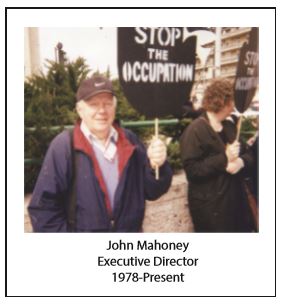
For the answer I need only look in the mirror. As a taxpayer, my tax dollars and those of all U.S. taxpayers have made Israel’s oppression possible. Over the years our military assistance has built this small county into the fourth most powerful one on earth. Our veto at the United Nations has been cast 42 times to shield Israel from draft resolutions that condemned, deplored, demanded, affirmed, endorsed, called on and urged it to obey international law.
Yet the colonizers continue their theft of Palestinian lands, and the Israeli military continues its hellish enforcement of the Emergency Defense Regulations, now enhanced by high-tech weaponry, security systems, and methods of pacification.
Only now Israel is exporting these technologies of control to other governments worldwide that are blurring the lines between military, domestic security agencies, and police in order to suppress the civil and human rights of their people.
So, “ No”. This is far from a 50-year celebration.
This is a reminder that, over the past half-century, a modest, nonprofit, educational organization, with contributions, small and large, from thousands of supporters, knew the truth, and spoke it.
